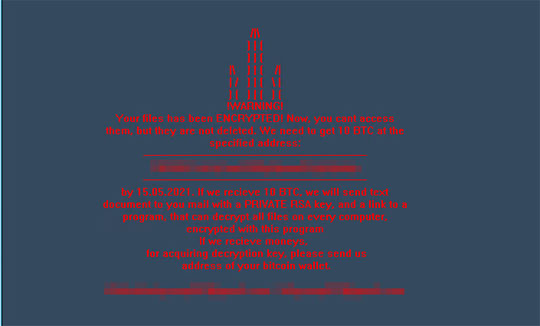Ransom.Win64.WhiteBlackCrypt.A
Ransom:Win64/FileCoder!MSR(MICROSOFT); Trojan-Ransom.Win32.Blocker.mwat(KASPERSKY)
Windows


Threat Type: Ransomware
Destructiveness: No
Encrypted: No
In the wild: Yes
OVERVIEW
Downloaded from the Internet, Dropped by other malware
This Ransomware arrives on a system as a file dropped by other malware or as a file downloaded unknowingly by users when visiting malicious sites.
It encrypts files with specific file extensions. It encrypts files found in specific folders.
TECHNICAL DETAILS
30,720 bytes
EXE
Yes
13 Apr 2021
Displays message/message boxes, Encrypts files
Arrival Details
This Ransomware arrives on a system as a file dropped by other malware or as a file downloaded unknowingly by users when visiting malicious sites.
Installation
This Ransomware drops the following copies of itself into the affected system:
- %ProgramData%\CheckServiceD.exe
(Note: %ProgramData% is a version of the Program Files folder where any user on a multi-user computer can make changes to programs. This contains application data for all users. This is usually C:\ProgramData on Windows Vista, 7, 8, 8.1, 2008(64-bit), 2012(64-bit) and 10(64-bit), or C:\Documents and Settings\All Users on Windows Server 2003(32-bit), 2000(32-bit) and XP.)
Autostart Technique
This Ransomware creates the following registry entries to enable automatic execution of dropped component at every system startup:
HKEY_CURRENT_USER\Software\Microsoft\
Windows\CurrentVersion\Run
CheckServiceD = %ProgramData%\CheckServiceD.exe
Other Details
This Ransomware does the following:
- It displays the following as ransom note:

Ransomware Routine
This Ransomware encrypts files with the following extensions:
- .DOC
- .DOCX
- .XLS
- .XLSX
- .PPT
- .PPTX
- .PST
- .OST
- .MSG
- .EML
- .VSD
- .VSDX
- .TXT
- .CSV
- .RTF
- .WKS
- .WK1
- .DWG
- .ONETOC2
- .SNT
- .JPEG
- .JPG
- .DOCB
- .DOCM
- .DOT
- .DOTM
- .DOTX
- .XLSM
- .XLSB
- .XLW
- .XLT
- .XLM
- .XLC
- .XLTX
- .XLTM
- .PPTM
- .POT
- .PPS
- .PPSM
- .PPSX
- .PPAM
- .POTX
- .POTM
- .EDB
- .HWP
- 0.602
- .SXI
- .STI
- .SLDX
- .SLDM
- .VDI
- .VMDK
- .VMX
- .GPG
- .AES
- .ARC
- .PAQ
- .BZ2
- .TBK
- .BAK
- .TAR
- .TGZ
- .GZ
- .7Z
- .RAR
- .ZIP
- .BACKUP
- .ISO
- .VCD
- .BMP
- .PNG
- .GIF
- .RAW
- .CGM
- .TIF
- .TIFF
- .NEF
- .PSD
- .AI
- .SVG
- .DJVU
- .M4U
- .M3U
- .MID
- .WMA
- .FLV
- .3G2
- .MKV
- .3GP
- .MP4
- .MOV
- .AVI
- .ASF
- .MPEG
- .VOB
- .MPG
- .WMV
- .FLA
- .SWF
- .WAV
- .MP3
- .SH
- .CLASS
- .JAR
- .JAVA
- .RB
- .ASP
- .PHP
- .JSP
- .BRD
- .SCH
- .DCH
- .DIP
- .PL
- .VB
- .VBS
- .PS1
- .BAT
- .CMD
- .JS
- .ASM
- .H
- .PAS
- .CPP
- .C
- .CS
- .SUO
- .SLN
- .LDF
- .MDF
- .IBD
- .MYI
- .MYD
- .FRM
- .ODB
- .DBF
- .DB
- .MDB
- .ACCDB
- .SQL
- .SQLITEDB
- .SQLITE3
- .ASC
- .LAY6
- .LAY
- .MML
- .SXM
- .OTG
- .ODG
- .UOP
- .STD
- .SXD
- .OTP
- .ODP
- .WB2
- .SLK
- .DIF
- .STC
- .SXC
- .OTS
- .ODS
- .3DM
- .MAX
- .3DS
- .UOT
- .STW
- .SXW
- .OTT
- .ODT
- .PEM
- .P12
- .CSR
- .CRT
- .KEY
- .PFX
- .DER
- .HTML
- .CSS
- .PY
- .GO
It encrypts files found in the following folders:
- Files found in fixed media drive or remote network drive
It appends the following extension to the file name of the encrypted files:
- .encrpt3d
SOLUTION
9.800
16.694.02
03 May 2021
16.695.00
04 May 2021
Step 1
Trend Micro Predictive Machine Learning detects and blocks malware at the first sign of its existence, before it executes on your system. When enabled, your Trend Micro product detects this malware under the following machine learning name:
- Troj.Win32.TRX.XXPE50FFF043
Step 2
Before doing any scans, Windows 7, Windows 8, Windows 8.1, and Windows 10 users must disable System Restore to allow full scanning of their computers.
Step 3
Note that not all files, folders, and registry keys and entries are installed on your computer during this malware's/spyware's/grayware's execution. This may be due to incomplete installation or other operating system conditions. If you do not find the same files/folders/registry information, please proceed to the next step.
Step 4
Delete this registry value
Important: Editing the Windows Registry incorrectly can lead to irreversible system malfunction. Please do this step only if you know how or you can ask assistance from your system administrator. Else, check this Microsoft article first before modifying your computer's registry.
- In HKEY_CURRENT_USER\Software\Microsoft\Windows\CurrentVersion\Run\CheckServiceD
- %ProgramData%\CheckServiceD.exe
- %ProgramData%\CheckServiceD.exe
Step 5
Scan your computer with your Trend Micro product to delete files detected as Ransom.Win64.WhiteBlackCrypt.A. If the detected files have already been cleaned, deleted, or quarantined by your Trend Micro product, no further step is required. You may opt to simply delete the quarantined files. Please check the following Trend Micro Support pages for more information:
Step 6
Restore encrypted files from backup.
Did this description help? Tell us how we did.

